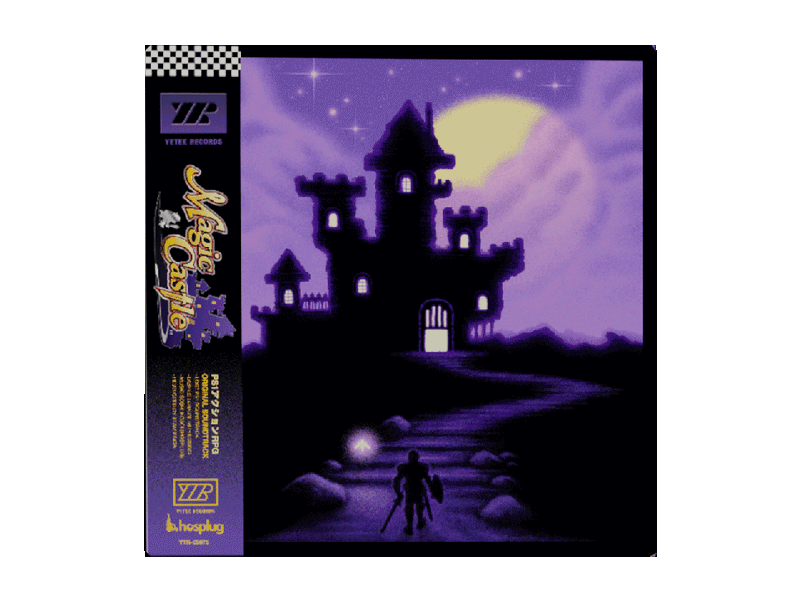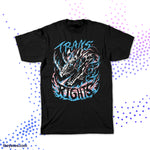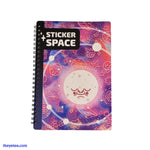
An Interview with Soshi Hosoi the Composer of Magic Castle
By Jacob Chase
Descend into the halls of a realm forgotten to time itself with Magic Castle by Soshi Hosoi. Coming exclusively to Yetee Records on purple and blue Twilight Mist vinyl, the soundtrack to KAIGA's PlayStation rogue-lite RPG twenty years in the making has finally emerged from the depths of its dormant hiatus to whisk us all away on a veiled journey straight to our turntables. Joining me on the blog this week is the game’s composer Soshi to help peel back the curtain behind this game’s playful and mysteriously ethereal score. But first, let’s take a look at why Magic Castle is so special, and why we are so excited to help bring its soundtrack to life on grooves!
Developed using Net Yaroze, a promotional development kit created by Sony for budding hobbyists and programmers, the device’s purpose was simple— to bring more people into the fold of the flourishing gaming division that Sony was cultivating. With the Net Yaroze in hand, the development team at KAIGA began harnessing this unique machine to bring their vision for Magic Castle to life. With a direct link to the game’s creation at a system level, the team and Soshi had the reins of Sony’s disc-based 90’s powerhouse in their hands and began using it to craft their dream.
Over the next eight months (1997-1998), the four-person team at KAIGA worked on manifesting that dream into reality. Comprised of the game’s designer and programmer Hiroyuki Itoh (aka PIROWO), SEGA game designer, producer, and director Keiichi Matsunami, Tetsuya Kanatani a programmer, and Soshi Hosoi, a composer and sound designer, the team created a technical beta that they began showcasing to various video game publishers. While initial interest was hit or miss, Sony saw potential in the studio’s future and wanted KAIGA to abandon Magic Castle altogether and begin work on a new project they had their sights on. Ultimately, the team rejected this offer and the story of KAIGA and Magic Castle faded away forever... until 2020.
PIROWO the game’s designer rediscovered the Magic Castle source code on a floppy disk in March of 2020, and by December had brought the dream of KAIGA out of the shadows and into the future. For the first time in over 20 years, Magic Castle was finally finished and unleashed upon the world. In addition to the game’s full release, Soshi Hosoi reprised his role as the game’s composer and sound engineer in order to recreate new tracks to flesh out the game’s final vision.
Magic Castle, for all intents and purposes, was ahead of the curve in terms of its genre combination and playstyle. The Rogue-Lite genre wasn’t all that unfamiliar back in the day, cult classics like Rogue had already set the pace, but the way in which KAIGA embraced the 3D-era and introduced randomization to the equation was something that absolutely would have pioneered the genre into what we know today— Games like Dark Souls, Binding of Isaac, and Hollow Knight are all bonafide industry standards at this point, and rightfully so. As the forerunners for what modern-day gamers associate with the term Rogue-Lite, these games all share quirks that are reminiscent of what makes Magic Castle so special. The whimsical and simplistic nature of randomized dungeons, weapons, and economy is very Nostradamus-esque of what we see in modern-day staples. Now that Magic Castle has been unleashed upon the world, it’s so captivating to boot up a ROM, sit back with a Bluetooth DualShock 4 on a modern PC, and take a literal portal back in time to experience what we’ve all come to know today in a bygone relic such as Magic Castle reborn. Something so ahead of its time, forgotten and all but lost... Here is the story of how its music came to be.

Soshi Hosoi, also known as “Hoso-Q” or hosplug is a renowned composer based out of Japan. Revered in the video game music scene for his work on famed titles such as the arcade and SNK-hit Sonic Wings, arrangement albums like the RAIDEN IV x MIKADO remix to Anime staples such as Rewrite, Onegai☆Twins, and more, Hosoi-san’s influence permeates what we attribute to soundtracks today! Working in the infancy of modern Japanese soundtracks, Soshi helped to forge what would become the worldwide phenomenon of electronically infused soundtracks inspired by the 80s & 90s culture of music in Japan. During our discussion, Soshi had confided to me who some of his greatest, and most influential composers and works were that led him down the path he's on today.
"I was heavily influenced by Joe Hisaishi and Steve Reich. In terms of game music, I was exposed to a lot of Sega, Namco, and Taito sounds from the 80s. As for interactive music, I learned a lot from Nintendo."
Joe Hisaishi and Steve Reich are definitely up there in terms of Hall of Fame composers in my book, and it's no surprise that Soshi gravitated towards their works. You can hear it in the music that he composes and with that early and formative Japanese compositional style infused with electronic vibes being ever-present on the soundtrack to Magic Castle, I just had to know what it was like working on such a divergent game coming off the heels of Sonic Wings.
"I've used the PlayStation development environment before, but this was my first attempt at interactive music, so I went through a lot of trial and error. I spent a lot of time trying to create a Nordic orchestral sound, unlike the techno music of Sonic Wings."
Playful pan flutes echo through the corridors of eons long past… A pirouette of wretched chords beckons you ever deeper into the threat-filled hallways winding with twisted vines and cursèd rats. The pounding percussion reverberating off the walls casts you sword first into wave after wave of endless slimes and undead foes— The only reprieve from the constant bombardment is the soft cascade of strings that lure you like a siren’s call to a lowly fountain off the beaten path— Allowing you a moment’s breath to meditate on the battles ahead before surging you on in an anthem to end the evil lord that inhabits these halls.
Soshi's prowess with the development environment of the PlayStation allowed him to harness the system to its fullest potential when crafting the music of KAIGA’s dungeon-delving adventure. Utilizing the real-time audio features of the system, he was able to bend the unique backend of the Net Yaroze to his will and layout the groundwork for the audio accompaniment that would make the world of Magic Castle feel alive. But what programs or instruments did he use to create the sweeping orchestral tracks we hear in the decrepit monster-filled corridors we can slash through today?
"I first composed a study using the SC-88 (also included on the vinyl). From there, I worked out how to make the music change interactively, and incorporated it into the PlayStation's built-in sound source. The instrument sounds were also recorded from the SC-88, and I didn't do any special processing other than using EQ. The sound of the SC-88 was excellent.
The DAW I was using at the time was MOTU Digital Performer. To create instrument sounds and sound effects, I used several waveform editing software, including the now-defunct BIAS Peak."

For those who may not know the Roland Sound Canvas 88, colloquially referred to as simply SC-88, is a beast of a half-rack MIDI sound module manufactured in 1994 and is regarded as being one of the greatest of its era. Honestly, the SC-88 still stands on its own today and is heavily used by retro enthusiasts and composers that want to capture that authentic analog experience that only hardware can produce. Given that the production of this album took place more than two decades prior, I was dying to know just how Soshi tackled the process of revisiting and creating new music for the final version of Magic Castle back in 2020.
"This was the first project I worked on after I became a freelancer. It was a work that packed a lot of what I wanted to do as a game’s music composer, so I feel like I've come back to my roots.
I was worried if I would be able to return to the same feeling since the sound sources I was using and my composing skills were different from those days, but surprisingly it was easy to get back to that mindset.
Unfortunately, we were unable to recreate the development environment of the time and create interactive music using the built-in sound source, but I think it mixes so well that you don't feel the gap of decades. The orchestral sounds in the new background music were created using the EAST WEST Quantum Leap Symphonic Orchestra. Also, my DAW has been replaced by Apple Logic Pro instead of Digital Performer. The new background music and sound effects were also implemented in the game, but it was not easy to add them to the limited memory."
With such a dynamic leap in time, the hurdles of modernized sound equipment weren’t a match to the experience that Soshi had cultivated over the years, and nothing is more evident of that fact than experiencing the music yourself in the final product. As Soshi mentioned, the original SC-88 tracks are still present and can be experienced on Side A of the vinyl soundtrack, but the arduous and painstakingly remade, and orchestral environment produced twenty years in the future still pack that nostalgic punch of that original development environment. Side B of the Magic Castle soundtrack contains those newly recreated tracks and encapsulates the original vision of Soshi’s work in the modern era. With such an intrinsic gravitas to the work from 1998 and 2020, I asked Soshi was his involvement was with the project as a whole, beyond just the sound and music.
"I was involved in the project from the idea stage, before it took on its current style. It was a fighting game with over 100 characters, and was completely different from the current project. I left the project halfway through, but when I came back, it had taken on its current form. From that point on, I have participated in the project only as a sound creator."
Huh, a fighting game? Now that would have been wild to see! It’s awesome to be able to dig into the intricacies of this almost abandoned project and get the inside scoop on what was, what could have been, and what has come to pass. I want to thank Soshi so much for taking the time to chat with me about this truly fascinating project and let me delve into some of the finer details of his work, it really means a lot!
If you are interested in checking out Magic Castle, you can scope out the official release and stay up to date with the project as PIROWO continues working on and updating the game over at Net Yaroze Europe page. I highly recommend that anyone who is even slightly interested in experiencing this unique piece of gaming history to go out and nab the ISO, pour over the extensive digital manual, and take that same portal back in time I did and immerse yourself in the world that only the team at KAIGA could deliver.
╱╲╱╲╱╲╱╲╱╲╱╲╱╲╱╲╱╲
The single LP soundtrack to Magic Castle is available to order exclusively from Yetee Records now, and comes housed inside a high-quality sleeve featuring artwork from our good friend Drew Wise and wrapped beautifully with an OBI strip by Marc Junker. This lovingly crafted soundtrack is a must-have for enthusiasts of hidden gems, PlayStation soundtrack fanatics, and collectors of unique pieces of gaming history. Fully mastered for vinyl playback, the Twilight Mist grooves will house the original tracks of Magic Castle from all the way back in 1998 in addition to the newly created tracks for the 2020 release by Soshi Hosoi.
If you’d like to stay up to date on all things Soshi Hosoi definitely go check out his website where he routinely posts updates and information on what he is currently doing in the video game music industry and beyond! He also has some social media pages and a YouTube filled with compositions and projects he’s worked on that I will link down below. Thank you so much for reading Yetee Fam!
Soshi Hosoi (hosplug)
Website: https://www.hosplug.com
YouTube: https://www.youtube.com/hosplug
Twitter: https://twitter.com/hosplug_hosoi
Facebook: https://www.facebook.com/hosplug
Instagram: https://www.instagram.com/hosplug_hosoi






